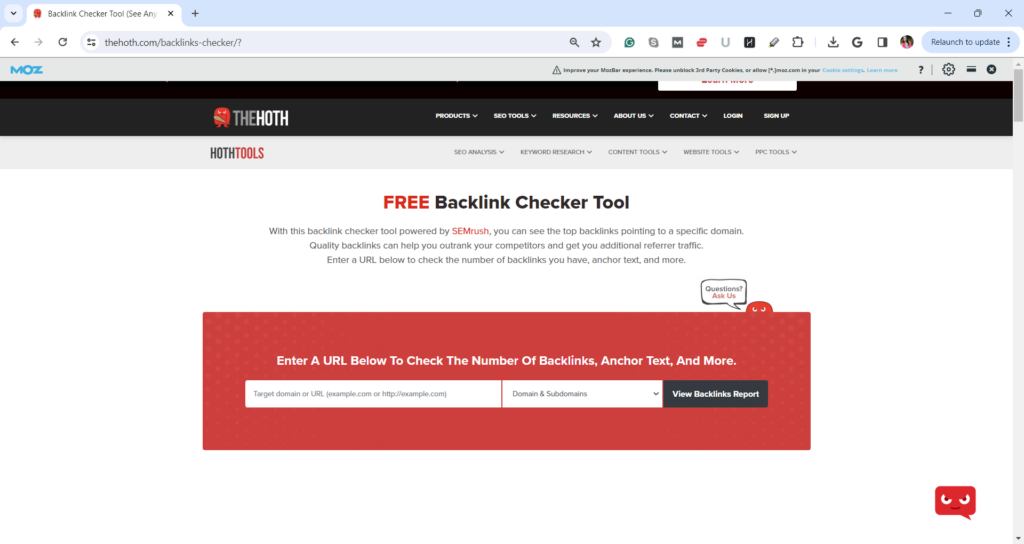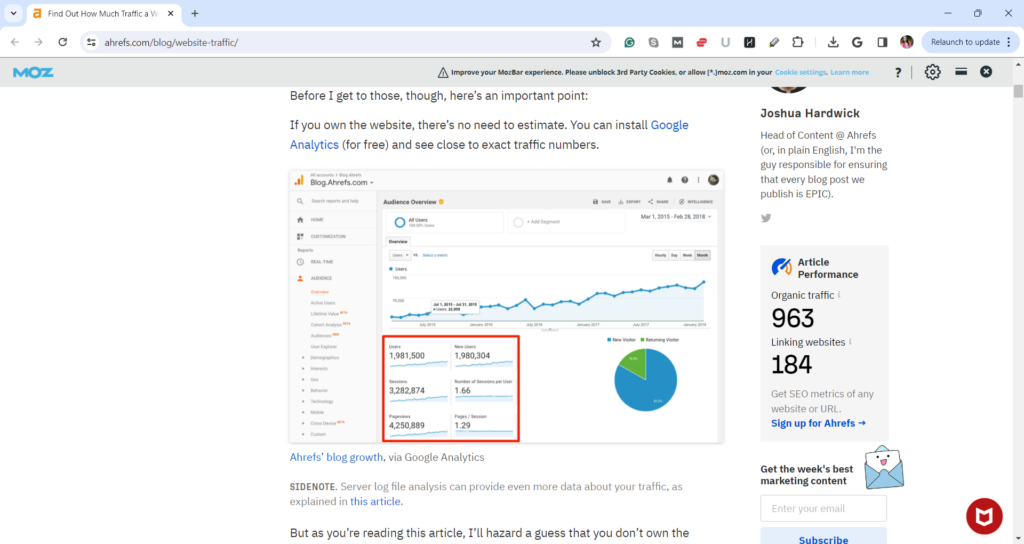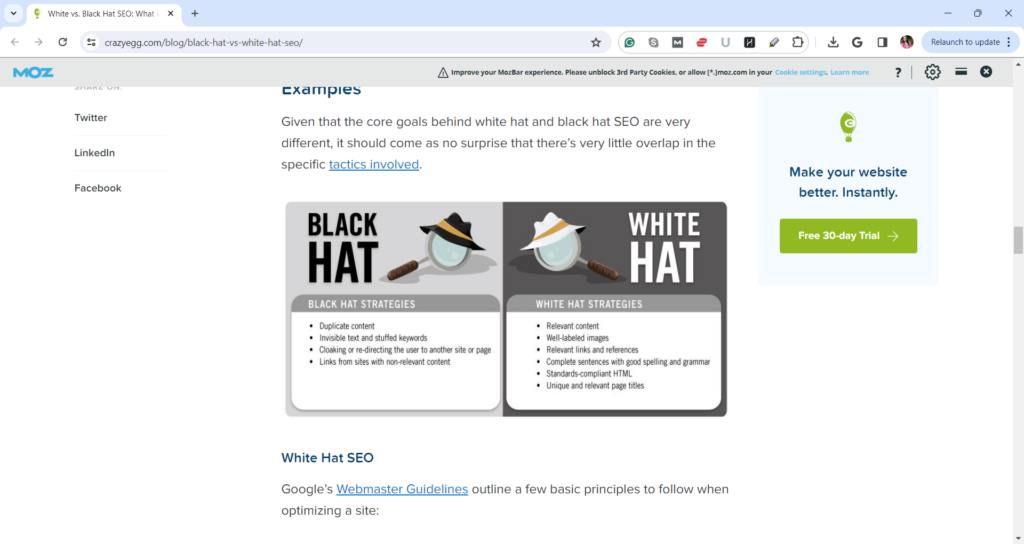What Is a Technical SEO Audit and Why Does It Matter?
Even the best-written content in the world won’t rank if your website is broken behind
Home » Traffic vs. Domain Authority For Backlinks: What Is Best

Even the best-written content in the world won’t rank if your website is broken behind
Google redefined the search experience with AI Overviews—a generative AI feature that instantly summarizes answers
Digital PR Strategy for SEO: A Complete Guide Digital PR is a modern approach to
Traffic and domain authority are two powerful ways to vet backlink quality—but is one better than the other?
Backlinks are indicators of quality, which is why search engines love them. Algorithms want to return the best results to searchers. So if a backlink is coming from an authoritative site, search algorithms are more likely to rank your site over one that doesn’t have great backlinks.
That said, not all backlinks are equal. If your backlink comes from a site with a low domain authority (DA) and/or the wrong traffic, it won’t matter as much in SEO compared to backlinks from websites with higher DA and traffic.
Let’s explore why traffic vs. domain authority matters in your backlink profile and how you can use SEO backlink software to build quality backlinks and top the search results.
According to a recent study by Siteefy, there are over 192 million active websites around the world, with a whopping 175 sites being created every minute. It’s a crowded space out there.
If you’re reading this article, then you probably own one of them. Most likely you’ve had first-hand experience of the struggles of staying on the first page of search results. At times, it can feel impossible to beat the competition and appear in the top results.
One way to stay on that elusive first page is by making sure that you’re partnering with other websites. These websites can link to you to send you free traffic and make you appear more credible and authoritative to search engines.
Google changes its algorithm up to 600 times per year and although a lot of these updates are minor, having a good backlink profile can help combat these.
In short, the more links going to your site, the higher you’re likely to rank.
Here’s how it works:
That’s a very basic way of how backlinking works and why it matters. There’s more to it, which we’ll touch on in a moment.
You can use a free backlink checker to get a quick snapshot of your backlinks, like this one:

Sometimes, these links will happen organically. Publishers love your content so much they want to link to it.
And sometimes, you’ll need to do some outreach to gain links. This might mean directly contacting publishers to ask for links. Or you might guest blog on other websites and add your own backlinks.
Or, you can use backlink software like SEOJet to find link-building opportunities.
No matter how you choose to build links, you need to think about the quality of those links.
That brings us to domain authority and traffic volume. Let’s explore the role of each.
Domain authority refers to a metric that shows how likely a website is to rank high in search results.
A common misconception is that DA is created by Google. However, it’s an independent metric given by Moz.

You can check any website’s domain authority for free.
The DA metric is measured on a scale of 1 to 100—the higher the DA, the more likely the website is to rank well.
Every website has a DA score. Newer websites will have very few backlinks and little traffic, so their DA rating is usually 3 by default. High-authority, high-traffic websites like Amazon and Facebook are usually 100 (or close to it).
An important thing to remember is that your site’s domain authority can increase and decrease. These fluctuations are relative to other similar sites as more, fewer, or different data points become available and are incorporated into those calculations.
It’s also worth noting that it’s much easier to grow your DA score from 10 to 20 compared to going from 70 to 80. Domain Authority should be used as a comparative metric against other similar sites.
Generally, sites with higher DA scores correlate with a higher likelihood of ranking, although there are a lot more factors at play. The actual Domain Authority calculation uses an algorithm to predict how your site compares to other similar sites based on search engine results. Good quality links play a part in this.
As you can see, backlinks, DA, and search engine results are all linked. Having a good SEO strategy for backlinking ensures that they all work together to provide a better user experience and in turn, increase traffic.
Search engine algorithms, like the ones used by Google, use the number of backlinks to your site as a key ranking signal. By having high-quality backlinks to your site, your overall site SEO will be impacted in a good way. But beware, not all backlinks are created equal.
Your domain authority can be impacted by the type of backlink going to your site, and this can affect your site in a negative way if you have the wrong type of link. If you have too many low-quality links pointing to your site, you can end up getting penalized.
Having a penalty against your site can see a drop in DA as well as decrease the likelihood of showing up on that all-important first page.
Traffic volume refers to how much traffic a website receives, usually measured on a monthly basis. It accounts for total traffic, not unique visitors. This metric indicates a website’s popularity and reach.
Another way website owners can vet backlink quality is by looking at a website’s traffic volume. The idea here is that high-traffic websites stand a better chance of sending you referral traffic because they have so many visitors.

This is important because more traffic to your website makes you look more credible. The “busier” your website, the better chance you have of ranking higher in search results.
It also stands to reason that websites with lots of traffic will have a higher DA compared to websites with relatively low traffic.
While both of these can be true, it’s important to note that neither are guarantees.
On paper, high traffic is a good thing. In reality, this isn’t the only metric you should focus on.
As with backlinks, you should be aiming for quality over quantity. If your site is receiving a lot of traffic, but these readers aren’t converting into leads or sales, then there’s something fundamentally wrong.
A way of checking if your traffic is low quality is by looking at other metrics, like your bounce rate metric. The industry average bounce rate falls about the 60% mark; however, if the bounce rate of your website is in the region of 80%, then it is a clear signal that your traffic quality is poor.
It’s also worth investigating the number of sessions per user and the time each person spends on your site. These are all good indicators as to whether the quality of your content isn’t captivating your readers, or that you’re attracting the wrong type of reader.
Ways of increasing traffic are to target more concise keywords with low difficulty and high traffic, create more cluster content, and of course work on your backlink strategy to gain readers more aligned with the content you’re creating.
Now that we’ve covered the role of DA and traffic in link-building, let’s look at a few other pieces for more perspective.
One of the last things you want to receive is a penalty against your site. But gaining too many low-quality links could result in exactly this.
Along with domain authority, every website is given a spam score. Essentially, this is given as a percentage, with 1%-30% being considered low. In the ideal world, you want to be below 5%.
Although a high spam score for your site doesn’t necessarily mean your site is spammy, it does mean that a large proportion of websites that make up your inbound link profile aren’t favorable.
If you do have a low-quality link profile, then it might be a good idea to investigate these linking sites further and if needed, disavow any links with higher spam scores. Disavowing links will tell algorithms to ignore those links when determining your website quality and rankings.
As tempting as it is, another big no-no in the eyes of backlinks is bought links. Not only are these often bad quality, but this is a surefire way of landing yourself a penalty.
You might think Google won’t know the difference, but remember we’re living in the era of Big Data. More companies are using AI to connect the dots and spot fraud. Google can simply look at patterns of links pointing to a website and know whether they were acquired authentically or with a credit card. It’s not worth the risk.
Buying and selling links that violate Google’s Webmaster Guidelines can negatively impact your site’s ranking in search results. It’s an easy hole to dig, but a difficult one to escape.
You might have heard the terms black hat and white hat being used in terms of link building, and the difference matters when choosing how to build backlinks.

A black hat link refers to the spam-oriented tactic of building links. These are designed to increase a site’s DA and cheat the system. This also includes bought links, which were mentioned earlier. They will often have little value with regards to the customer’s experience, nor enhance your content.
The reasons black hat backlinks are a no-go are many:
White hat linking is a term used to get links in a more organic way. It is not frowned upon by Google. If you have good-quality content on your site, other sites will naturally want to link to you. The aim is to add more depth to a topic and aims to benefit the user.
White hat links have many advantages over black hat links:
When vetting the quality of backlinks, it’s important to consider white hat vs. black hat indicators alongside traffic and DA.
In other words, don’t just choose links based on DA or traffic!
You need to consider the complete picture of how your backlinks will help or harm you.
Now for the million-dollar question: What’s better, large volumes of traffic or higher DA?
Something to bear in mind is that a high DA and large traffic volumes aren’t mutually exclusive. It is possible to have one without the other.
A site can have a high DA and low traffic, especially if they have been using some form of free backlink software and worked on niching down to a small but very focused audience.
In contrast, it’s also possible to have a low DA and high traffic, especially if you have a strong presence on social media, where you’re driving readers and customers to your site without needing to perform well in search engine results.
As with most things in life, it’s all about balance. Ideally, you want to have both; a good DA as well as referral traffic. One way to gain traction in both is to opt for quality backlinks as opposed to quantity.
By implementing some sort of backlinks software, you can speed up and improve this process.
Although you could carefully analyze what your competitors are doing manually, this process can be laborious. It takes a lot of time.
By implementing automatic backlink software and tools, you can compare what the link profiles of your competition look like and work on a strategy to outrank them much more efficiently.
Using traffic link software like SEOJet, you’ll be able to quickly produce reports of each result from page one of search results. Not only will you discover what content is on their page compared to yours, but you’ll also find out which key phrases they’re using in their anchor text. Peek at their entire portfolio to laser-focus your link-building efforts.
So, do you want to stop playing the guessing game as to what your competitors are ranking for and have a plan in place that actually works?
We handle the Traffic vs. Domain Authority debate on your behalf, ensuring you can balance each and get the results you want.
If you’re even thinking about amplifying your backlinks game, book a free strategy session and speak to a member of the team. Discover how we can help you build a customized backlink plan for every page of your site using accredited, top-ranking data from Google.
No more guessing what words to use in your anchor text, no more unnatural or weak backlinks, just accelerated SEO and traffic growth!